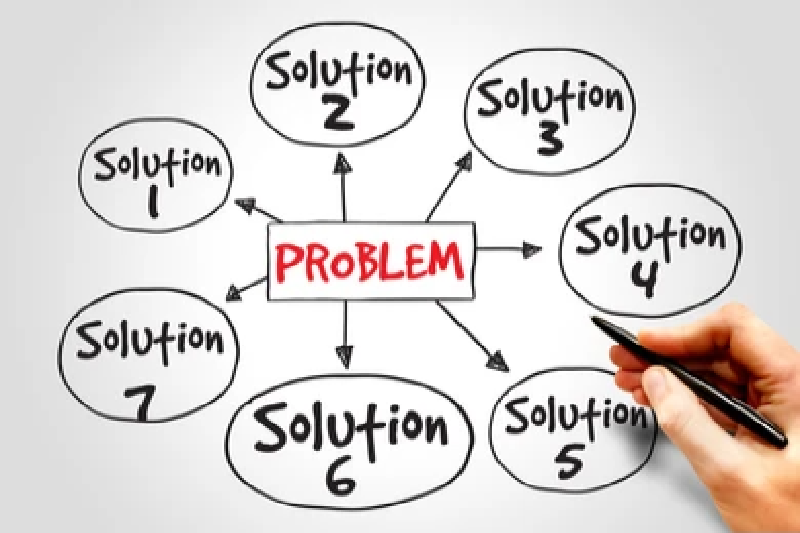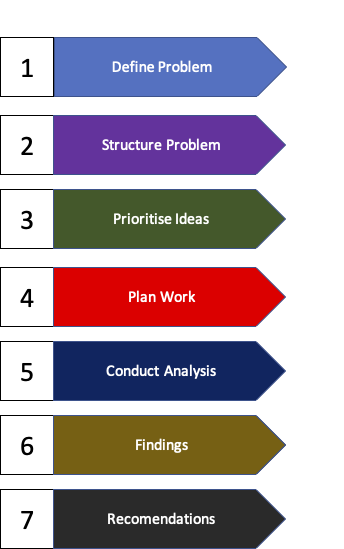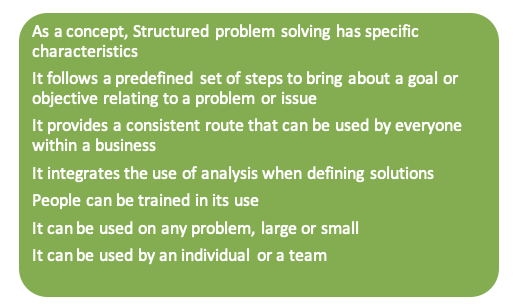Structured problem solving is an organized process that describes a set of steps that guide a user (or group) through the process of identifying, analyzing and resolving problems.
By applying a set structure to the problem solving process, users increase the opportunity of a successful outcome. This is primarily achieved through the use of data and analysis when determining potential solutions.
We’ll be covering structured problem-solving in today’s article; we’ll be covering:
- What is structured problem solving
- Where can you use structured problem solving
- Steps in structured problem solving
- Who uses structured problem solving
- How to do structured problem solving
- Structured vs Unstructured problem solving
- Benefits of structured problem solving
- Issues of structured problem solving
What is structured problem solving
Resolving problems is one of the most fundamental concepts in business or our personal lives.
Indeed, problem solving is one of the most sought-after professional skills.
Problems can occur in everyday lives, from examples such as “my automobile won’t start this morning” to complex business problems like “we’re not going to meet a customer deadline; what do we do?”
Problems may arise in any circumstance, and being able to help resolve them swiftly and simply can help your business in several ways, from preventing unnecessary costs to improving efficiency.
As the consequences of problems are shrouded in uncertainty, resolving them successfully must be a key goal of any organization.
There are many tools and concepts to help analyze, assess and resolve problems from 5 why’s, PDCA, and Gemba.
Having a clear, structured and straightforward process to follow when faced with complex issues where there is uncertainty puts you in a higher stance of successfully resolving them.

By following steps, we not only understand the problem (and its moving parts) more clearly but also possible solutions and their consequences.
As a concept, Structured problem solving has specific characteristics
- It follows a predefined set of steps to bring about a goal or objective relating to a problem or issue
- It provides a consistent route that can be used by everyone within a business
- It integrates the use of analysis when defining solutions
- People can be trained in its use
- It can be used on any problem, large or small
- It can be used by an individual or a team
Where can you use structured problem solving
As we highlighted earlier, there are various tools that can be used in problem solving.
There tend to be two broad problem types
- Structured problems
- Unstructured problems
We cover these later in the article; which tool to use largely depends on the type of problem you’re faced with.
Steps in structured problem solving.

There are numerous versions of structured problem solving, each with its own subtle spin, these include
- 7 Step problem solving (McKinsey format)
- Define problem
- Structure problem
- Prioritize ideas
- Plan work
- Conduct analysis
- Synthesize findings
- develop recommendation
- 5 Step problem solving
- Identify the problem
- Generate ideas
- Evaluate ideas
- Decide on a solution and try it
- Review
- 6 Step problem solving –
- Identify and define
- Brainstorm ideas
- Consider all options
- Chose a solution
- Implement solution
- Review and refine

All of these will use the approach of test and learn and iterate, i.e. come up with a hypothesis of what’s going on and how to fix it, test this hypothesis and refine it.
Every problem requires careful consideration and approach, from understanding associated risks to determining what data may be available to understand it and how we approach it statistically.
As we showed in some of the examples above, there are some common steps; these include:
1 Define your problem – this is surprisingly challenging. One of the most common issues is that people miss this step and fail to understand the true nature of the problem they face (including its impact, dependencies, complexity etc.). The result of getting the problem definition incorrect is that it is then likely to drive the deployment of an incorrect solution.
One key thing to avoid in this step is solution identification; this is not the purpose of this step.
2/ Structure problem – a problem is likely to be built up from a variety of issues. Structuring the problem means breaking the problem down into its “moving parts” what are the key drivers behind the current output?
3/ Prioritise issues – Once you have understood what the problem is, you now need to prioritize the issues, this may require some analysis.
4/ Plan work – this stage plans work, specifically around how you will assess the problem and analyze results. It’s highly likely that this will involve a series of test, assess and retest. You may also test a number of areas before you find your solution.
5/ Analyse – Gather data and assess in the context of your problem.
6/ Synthese findings – Using work produced in previous steps, assess data and develop your findings.
7/ Develop recommendation / solution – Validate and implement your solution.

Who uses structured problem solving
While we all face a level of challenge in our day-to-day working life, there is a common misconception in businesses that solving complex business problems is either a leadership or Quality department problem.
Of course, the counterargument is that problem solving really is down to everyone within a business. However, it’s not as straightforward as that.
Problem-solving without a plan or process will only get you so far. Sure some will be lucky and implement solutions that drive answers, but for the vast majority, mileage will vary.
As a result, problem solving can be defined into two parts
1/ Establishing the process that should be followed
2/ Executing the problem solving process
While you could argue that point 1 is a leadership role, it’s the role of people within the organization who know what successful problem solving is.
It also requires some key ingredients.
- Resources
- A level of experience in problem-solving (this doesn’t have to be the whole team but certainly some and ideally those leading the task)
- Data (so can you base hypothesis on fact)
- Methods/tools that can define the probable cause (e.g. five why)
- Methods to model solutions
Executing the problem-solving process is (once they’ve been trained) down to everyone; this could be
- Individuals
- Teams
- Consultants
- Businesses
How to do structured problem solving
The simple answer is you do whatever your process tells you to, stick to it and don’t deviate (the most common issue is you’ll think you know better).
Let’s take a look at our 5 step process from earlier in the article and scrutinize how we might practically approach the task.
1/ Identify the problem
Identifying or defining your problem usually means writing a problem statement. The devil is certainly in the detail here, and problem-solving will only be as good as how well you have defined the problem in the first instance.
Good problem statements usually have specific characteristics
- They are specific
- They are succinct
- They are measurable
- It is clear what is impacted
Defining problems is not straightforward; give this step sufficient time to produce something that supports the process. Note that this step drives the others; you cannot come up with remedies if you haven’t defined the issue properly.
Remember, you (or your team) do not have to define your problem in isolation and data with a level of analysis here can help.
2/ Generate ideas
This step usually involves some areas of brainstorming, but you should support that with good supporting data.
The critical part here is to spend time. Do not settle on the first idea you come up with or get wedded to a solution because you think “this is it”, it may not be.
Remember, at this stage, the role is not to evaluate solutions but to generate them.
If your undertaking this task as a team, be sure to give everyone in the team a voice. No idea, at this stage, what is wrong.
3/ Evaluate ideas
Once you have some possible solutions, the next stage is to evaluate them.
You’ll likely treat this stage as a sifting process where you look through some ideas and devise possible solutions.
Part of the ask of this stage is to answer the question of “this will work because”. As such, this is likely to involve data and analysis (if we change x we get y results). You’ll likely need data to support your hypothesis, including some analysis.
This part of the process should result in you determining the most likely effect of a given choice and the results it might deliver.
There are likely to be business impacts to this that should be considered, whilst ideal things are not expected to be all upside, and pros/cons will need to be established and reviewed.
Remember also that you don’t have to only pick one solution. There may be numerous possible candidates that you’ll want to take to the next stage.
4/ Decide on a solution and try it
The next stage involves testing to see whether your hypothesis around the problem solution can be substantiated. This will vary in size and shape depending on the complexity of thethe issue (and your business environment)
You’ll also want to consider how you’ll capture data that indicates the results.
5/ Review
Once you have your results, you’ll be able to undertake a level of impact analysis to help ascertain which solution to roll out.
There may well be some levels of delegated authority that need to be navigated around, mainly if the solution involves cost outlays or significant process change.
One of the key reasons people fail to get the results from a structured problem-solving process is that they think they know the answer, so they skip parts thinking that they’re superfluous, but what they are doing is failing to scrutinize the hypothesis or proposed solution effectively.
6/ Deploy your solution or tweak
Once you’re content that your solution delivers what you need, you can complete your deployment. If it requires modification, then you can jump back to an appropriate earlier stage and start again from there (the stage you’ll jump back to will depend on the level of success experienced).
Structured problem solving vs unstructured problem solving.
We’ve talked a lot in this article about how we can break down the problem, analyze them and, hypothesize about improvements, then test and iterate to solve issues.
That works well when business problems can be addressed that way.
That’s not always the case.
Unstructured problems have varying characteristics that make the traditional structured approach more challenging.
Unstructured problems have some specific characteristics
- Variables may not be identified before the problem occurs
- Variables may shift during the problem
- They are typically random events.
- They are often high impact
- it’s not uncommon that problem solving is required at a fast pace
- They are often highly complex
As we’ve shown, people undertaking problem-solving usually benefit from structure, but when you are faced with a problem that was perhaps unexpected, unprecedented and shifting in its outcomes, problem-solving can be difficult. Take, for example, when a hurricane hits.
It’s not uncommon to use a process (often the same process as structured problem solving), but data analysis (if available) is unlikely to provide all the answers.
As a result, solving unstructured problems often relies more on experience and intuition to define solutions. Given the complexity and impact this has, it’s typical for those in leadership positions to have the final call.
Benefits of structured problem solving.
Problem-solving is something that we all do every day to some degree. Having a structure to follow can drive several benefits; these include:
- More likely to deliver the desired outcome
- Focus on facts and data
- Can highlight systematic or recurring issues
- Can provide pace within problem solving process
- Helps in communicating problems so that everyone can clearly understand the issue and possible remedies
- includes impact analysis of outcomes
- Usually includes evaluation and test (and change if necessary)I
Issues of structured problem solving
As with any process, there are some issues to watch out for; these can include
- Bias towards a potential solution
- Believing you have the answer before you’re finished (and failing to complete all steps in your process)
- Unable to obtain useful data on which to base analysis
- Problem-solving teams aren’t empowered to make decisions.
- Solution boundaries are not understood, and inappropriate solutions are tested/implemented (i.e. solution would cost $1 Million to solve a $200k problem)
Summary
Problem-solving is one of the most common challenges we face in our professional and personal lives.
Structured problem solving provides a consistent and repeatable workflow for breaking down complex problems and driving solutions.
The key to having a structured process is to avoid “freestyling” solutions that may not actually fix the issue. A structured approach is the best way of fixing a problem.
Does your organization utilize structured problem solving? Do you have tips that you’d like to share with our audience?
As ever, you can use the comments section below or reach out to us on Twitter.
